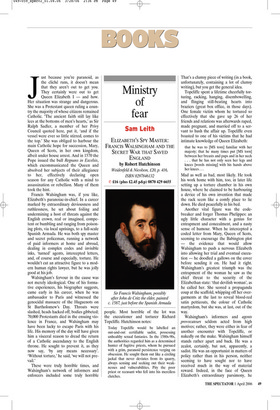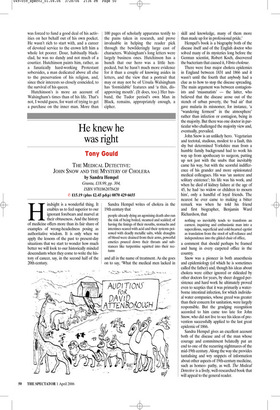Ministry of fear
Sam Leith
ELIZABETH’S SPY MASTER: FRANCIS WALSINGHAM AND THE SECRET WAR THAT SAVED ENGLAND by Robert Hutchinson Weidenfeld & Nicolson, £20, p. 416, ISBN 0297846132 ✆ £16 (plus £2.45 p&p) 0870 429 6655 Just because you’re paranoid, as the cliché runs, it doesn’t mean that they aren’t out to get you. They certainly were out to get Queen Elizabeth I — and how. Her situation was strange and dangerous. She was a Protestant queen ruling a country the majority of whose citizens remained Catholic. ‘The ancient faith still lay like lees at the bottoms of men’s hearts,’ as Sir Ralph Sadler, a member of her Privy Council quoted here, put it, ‘and if the vessel were ever so little stirred, comes to the top.’ She was obliged to harbour the main Catholic hope for succession, Mary, Queen of Scots, in her own kingdom, albeit under house arrest. And in 1570 the Pope issued the bull Regnans in Excelsis, which excommunicated the Queen and absolved her subjects of their allegiance to her, effectively declaring open season for any Catholic with a mind to assassination or rebellion. Many of them took the hint.
Francis Walsingham was, if you like, Elizabeth’s paranoiac-in-chief. In a career marked by extraordinary deviousness and ruthlessness, he set about foiling and undermining a host of threats against the English crown, real or imagined, competent or bumbling and ranging from poisoning plots, via local uprisings, to a full-scale Spanish Armada. He was both spy master and secret policeman, running a network of paid informers at home and abroad, dealing in complex codes and invisible inks, ‘turned’ agents, intercepted letters, and, of course and especially, torture. He wouldn’t cut an attractive figure to a modern human rights lawyer, but he was jolly good at his job.
Walsingham’s fervour in the cause was not merely ideological. One of his formative experiences, his biographer suggests, came early in his career, when he was ambassador to Paris and witnessed the genocidal massacre of the Huguenots on St Bartholomew’s Day. Throats were slashed, heads hacked off, bodies gibbeted; 70,000 Protestants died in the ensuing violence in France, and Walsingham may have been lucky to escape Paris with his life. His memory of the day will have given him a visceral reason to dread the return of a Catholic ascendancy to the English throne. He sought to prevent it, as they now say, ‘by any means necessary’. ‘Without torture,’ he said, ‘we will not prevail.’ These were truly horrible times, and Walsingham’s network of informers and enforcers included some truly horrible people. Most horrible of the lot was the executioner and torturer Richard Topcliffe. Hutchinson notes:
Today Topcliffe would be labelled an out-and-out certifiable sadist, possessing unhealthy sexual fantasies. In the 1580s-90s, the authorities regarded him as a determined hunter of fugitive priests, whom he pursued with a grim, paranoid persistence verging on obsession. He sought them out like a circling jackal that never deviates from its quarry, always sensing and seeking out their weaknesses and vulnerabilities. Pity the poor priest or recusant who fell into his merciless clutches.
That’s a clumsy piece of writing (in a book, unfortunately, containing a lot of clumsy writing), but you get the general idea.
Topcliffe spent a lifetime cheerfully torturing, racking, hanging, disembowelling, and flinging still-beating hearts into braziers (great box office, in those days). One female victim whom he tortured so effectively that she gave up 26 of her friends and relations was afterwards raped, made pregnant, and married off to a servant to hush the affair up. Topcliffe even boasted to one of his victims that he had intimate knowledge of Queen Elizabeth:
that he was to [MS torn] familiar with her majesty; that he many times put [MS torn] between her breasts and paps and in her neck . . . that he has not only seen her legs and knees [words missing] with his hands above her knees . . .
Mad as well as bad, most likely. He took his work home with him, too, in later life setting up a torture chamber in his own house, where he claimed to be harbouring a device of his own invention that made the rack seem like a comfy place to lie down. He died peacefully in his bed.
Another vital figure was the codebreaker and forger Thomas Phelippes: an ugly little character with a genius for entrapment and concealment, and a nasty sense of humour. When he intercepted a coded letter from Mary, Queen of Scots, seeming to encourage the Babington plot — the evidence that would allow Walsingham to push a nervous Elizabeth into allowing her trial and eventual execution — he doodled a gallows on the cover before sending it on. He had it right. Walsingham’s greatest triumph was the entrapment of the woman he saw as the chief threat to the security of the Elizabethan state: ‘that devilish woman’, as he called her. She scored a propaganda coup at the scaffold, whipping off her overgarments at the last to reveal blood-red satin petticoats, the colour of Catholic martyrdom, but she was, at last, out of the way.
Walsingham’s informers and agents provocateurs seldom acted from high motives; rather, they were either in fear of another encounter with Topcliffe, or nakedly on the make. Walsingham himself stands rather apart and back. He was a zealot, certainly, but not, apparently, a sadist. He was an opportunist in matters of policy rather than in his person, neither seeming to have sought nor to have received much in the way of material reward. Indeed, in the face of Queen Elizabeth’s extraordinary parsimony, he was forced to fund a good deal of his activities on her behalf out of his own pocket. He wasn’t rich to start with, and a career of devoted service to the crown left him a whole lot poorer. Dour, habitually blackclad, he was no dandy and not much of a courtier. Hutchinson paints him, rather, as a fanatically hard-working Protestant sobersides, a man dedicated above all else to the preservation of his religion, and, since their interests so closely coincided, to the survival of his queen.
Hutchinson’s is more an account of Walsingham’s times than of his life. That’s not, I would guess, for want of trying to get a purchase on the inner man. More than 100 pages of scholarly apparatus testify to the pains taken in research, and prove invaluable in helping the reader pick through the bewilderingly large cast of characters. Walsingham’s long letters were largely business ones. Hutchinson has a hunch that our hero was a little henpecked, but he hasn’t much more evidence for it than a couple of knowing asides in letters, and the view that a portrait that may or may not be of Ursula Walsingham has ‘formidable’ features and ‘a thin, disapproving mouth’. (It does, too.) Her husband, the Tudor period’s own Man in Black, remains, appropriately enough, a cipher.



























































































 Previous page
Previous page